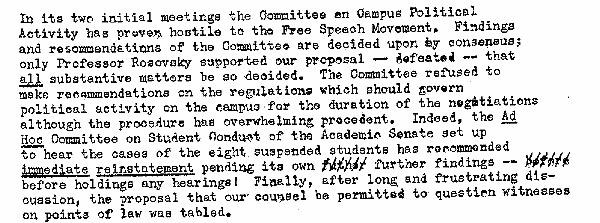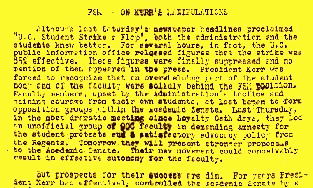Scanned Leaflets here
The Leaflets of the Free Speech Movement:
An IntroductionHere are the leaflets of the FSM, the paper life-blood of our movement, in all their glory, or nearly. You can see how drab they appeared, with dense blocks of text stretching sometimes to all margins as we crammed them with vital information.
No trace of graphic ornament relieved their monotony, for activists still wore dowdy blue work-shirts and jeans and didn't even think of making posters until the next conflict began. You can see how we used colored paper to try to decorate their flow, and how this made them even harder to read. But no picture can really show you how the leaflets felt, how the mimeograph ink seepedthrough the cheap paper we used to obscure the text on the other side, or how often the print was so patchy and faint that you had to find someone else wearing an FSM button with another copy to puzzle out together what a crucial passage meant, and what to do about its meaning.
You can read their digitized texts here without such complications. But if you look closely at their images, you can also read the raw traces of our productive process -- not only in the blotchy print of mimeos running low on ink and cheap stencils wearing thin as weary arms cranked the umpteen-thousandth copy through, but in the very words, in the typos and misspellings, the hasty and awkwardly precise phrasings, the mistakes typed over or just crossed out. Most of our leaflets were written at 3 a.m., after an afternoon meeting of the Steering Committee finally broke up, by a few of us who struggled to condense the meeting's sense to fit on a page, in time to rush this to the volunteer who stayed up to type the mimeo stencil in time to rush it to others who still stood by waiting to crank out the first thousand copies in time to give to those alerted by phone-tree last night to be ready at dawn to hand out the leaflets, smudgy with fresh ink, to students arriving for early classes at all the gates of the campus.
By such means, as well as face-to-face, we spoke to ourselves about meanings, purposes, and urgent tactics, in a flood of paper discourse springing not only from the FSM's Steering Committee, but from all its other centers of organizing among the graduate students and teaching assistants, in the many departments and the dorms, and from sympathetic ministers, Marxist analysts, crank visionaries and dissident complainers. All together, during three months of conflict, in this last moment before the flourishing of "underground" newspapers began, we must have produced three hundred leaflets and pamphlets and printed a million pages, heady with the power of talking to each other.
As you passed through Sproul Plaza you could pick up three or four and linger to sort out their slants, the meaning of new developments, in the energized atmosphere of a political community awakening.
In the leaflets posted here, you can read the public story of the conflict, at least from our side -- how we understood the issues and stakes, the progression of events. But the deeper tale they tell is of who we were. We were crazy, we were fanatics: we actually believed in the First Amendment, in the power of free speech. We believed that rational discourse and appeals to principle could move people to action. We thought it reasonable to expect that our sisters and brothers would study the dense patchy text of our reports, understand the legal intricacies of the FSM's position, think through the complex issues and the urgings and risks of personal involvement. We believed that free speech was the key to future justice on everyone's behalf, and vital to defend on our home ground; we believed we could win it by using it. Our leaflets were the exercise of our belief, and proved us right.
Michael Rossman
October 1997
date of last revision 20 Mar 2002

